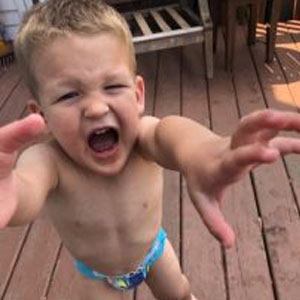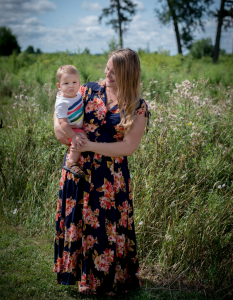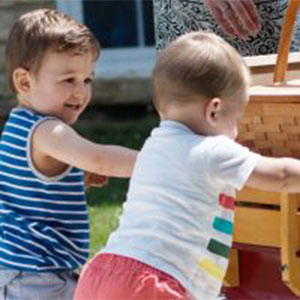
by Jessie Cooper | Jan 6, 2020
Over the last two weeks, we’ve taken a deep dive into attention-seeking behavior and behavior maintained by escape. If you’ve been following along, I’m hoping these blogs have helped you and you’re starting to see some patterns in your little sweetheart. If you’re new to the blog, welcome! Just click here to take a peek at what you’ve missed.
The world we live in is a beautiful place, full of choice and products. We’re very blessed in this way. Every person spends their lifetime building up preferences and favorite things. Some of this comes from within us (nature), while some of it is from what we’re taught (nurture). But all of it comes from us navigating our environment. This starts as soon as we move from the squishy, wonderful newborn phase into the active baby phase.
How Your Child Develops Preferences
Think about it. You’re a tiny little baby around the ripe age of, say, five months. Your parents are getting ready to give you a big spoonful of your first real food! They anxiously await your reaction to the food they’ve chosen (nurture) and you respond (nature)! For my boys, I’m super into training their pallets to love real food. I made a point to do green veggies at 5 months for both Henry and Declan. Henry downed his broccoli and to this day has not shied away from eating his vegetables first (unless salmon or applesauce make an appearance). Declan was not as impressed. It turns out he really hates puree, is OK with most veggies but does not like the texture of broccoli. He would eat muffins all day if we let him! Now, in giving these examples, no problem behaviors are happening, but I’m hoping it’s giving you a picture of how preferences for tangibles start. We as parents provide the exposure and our children respond with preferences.
From infancy into childhood and beyond, each exposure to something new builds up a list of likes and dislikes. To children, the world is their oyster. While toddlerhood is an extremely hard phase for any parent, it’s also a joyful one, as your little someone begins to build into the person they will become. But this little person, as I’ve said many times, is all limbic system. This means when your toddler decides they either like or don’t like something and you either withhold a preferred item or ask them to use a disliked item, their response is, “fight, flight, freeze.” This goes on all day long for most toddlers from about 18 months to three years of age. Around age three the prefrontal cortex (our logic center) starts to develop and these Big Emotions, while present, are not so intense.
Coping with Your Child’s Preferences and Behavior
So what does this look like for you, for me, and for our children? It looks like our toddlers asserting their preferences very noisily and us learning how not to lose our shit. Honestly, if you are interested in this kind of stuff, you should read “How Not to Lose Your Shit with your Kids,” it’s a lifesaver for this phase!
For the last 8 months at our house Henry (now 2 ½) has been going from passionately happy to emotionally distraught, which is centered around access to items he wants. It starts when he wakes up and wants a drink, but not just any drink. It could be water, juice, a smoothie, or almond milk (he’s lactose intolerant). If he’s allowed to have the requested item, he shows joy. If my husband or I say, “No,” his world crumbles. Fight, flight, freeze. This cycle goes on for the whole day; what bowl he wants to eat from, what fruit he wants for snacking, can he have a treat (usually chocolate), can he watch a show and so on and so forth. In writing all this down, it seems exhausting and it is. But it’s also who Henry is at the age he’s at.
There is a world full of endless choice and reinforcers that await him. Watching Henry show joy toward finding his reinforcers is magical. What isn’t magical is when he’s asking for something and the answer is, “No.” As a parent, it would be easier to say, “yes!” all day to every request because then the tears would stay at bay. However, it’s also my job as his (and his brother’s) mama and to teach them tolerance to disappointment, moderation of fun-but-bad-for-you stuff (sweets, processed foods, and technology at our house), and how to wait. This can suck in the moment because you know that in saying, “No,” a behavior may follow. But what follows much later is a skill set you can be proud of as your little ones grow.
Now, of course there are times we all need to give in. But this need comes from you and not for your child. It’s not about making them happy with a third movie, it’s about giving you a break. We, the parents of toddlers or children with limited verbal ability, like some children with autism, are a tired breed. We get run down too and sometimes that 100th, “No,” is just beyond you or me. It’s OK. Give in. But know when you are giving in and let it serve as a warning sign that you are in need of some self-care and alone time ASAP. Once you get some R&R time, you are recharged and can decide to buckle in and drive back down the road of helping your child navigate their choices with you driving–not them.
Getting Help for Your Child
If your child is very young (or getting older but is not verbal) with autism, this is where Applied Behavior Analysis (ABA) can help. You see the world is still full of beautiful choices for your child, but they may not have the voice or ability to say what their preferences are. Or they may not have the skill set to wait for their favorite items. Teaching children with autism how to communicate what they want and who they are is by far the most rewarding part of work in ABA. If a child gets access to intensive ABA from two-years to five years of age (think 20-40 clinic hours a week), their chance at full verbal language is tremendous. In teaching speech, we’re opening up their world to tell us everything they love. And who doesn’t love that!
Xoxo,
Jessie

by Jessie Cooper | Dec 26, 2019
Last week we dove into attention-maintained behaviors and what to do when your little one is engaging in challenging behaviors to gain your (or others) attention. This week we’re going to jump into talking about what to do when your child is engaging in problem behaviors to access escape. So, in turn, we’re going to talk all about my son, Henry.
To begin let’s remember the recipe for identifying if your child is engaging in problem behavior to escape your demand. First, you, as the parent, ask your child to do something. Next, your child engages in a behavior that is uncomfortable for you. Lastly, you remove the demand to avoid the behavior. Look at the middle part again. “Your child engages in a behavior that is uncomfortable for you.” What this means is your child has figured out what behavior they can use to make you essentially back off. As a mama this is tough. I know this as a clinician, but I’m also living it.
A few weeks ago we talked about making a list of behaviors that are not OK in your home. My list was hitting, spitting, and yelling at an adult. Henry does all three of these things every day at some point to escape my demands. “Now wait a second!” you’re saying. “You are our guide, the ticket out of these behaviors and your son does these things on a daily basis?” Yes, but stay with me!
Raising A Strong-Willed Child
Henry, from infancy, has been a strong-willed child. I’m a strong-willed woman and Henry’s Daddy is Bulgarian, so he got a double dose of stubbornness.
I remember writing this in Henry’s baby journal, “I didn’t know babies came out like you.” When we were sleep training Henry at 6 months, he would lay on his belly popping his pacifier in and out of his mouth watching the door then when we walked in he’d flip over and start crying. Smart little guy. Since then it’s been a steep learning curve to stay ahead of Henry. He is a bright child, full of love, life, and in his little brain, he knows best.
Henry has strong opinions about how his day should go. When I tell him it’s potty time, or it’s time to get dressed, or he needs to sit to eat, and so on and so forth, he will challenge me. Normally it’s just a vocal comment and an attempt to negotiate with us (negotiating with a two-year-old is tougher than it sounds!) to which I stand my ground most days. When it comes time to follow through with a task I need him to do (normally dressing, potty, buckle to eat), however, Henry will yell, hit, and even spit at times.
These behaviors first started to ramp up around the time we welcomed Henry’s brother, Declan into our lives. I wasn’t capable of finding the function, making a plan, or teaching a new skill when Henry’s new behaviors started. I was barely hanging on at the time and all I could give was showing up to get through the day. Henry’s new behaviors took hold mainly because I was occasionally reinforcing them (“Ok Henry, sit wherever just eat”). Henry learned that if he used these three behaviors (yelling/hitting/spitting) I would get pissed and give in from time to time. This was not a fun dance.
Working on Yourself to Help Your Children
Over the past few months, I’ve been working hard at calming down my own nervous system to be a better mama. Two kids under two is hard. I’ve been asking myself what I need to be able to do to take a step back and truly help my son by helping myself. It was in taking this step back and working out more, meditating more, playing more–working on me more–that I could objectively see his pattern. Before this point, I was just putting myself down, telling myself that as a clinician I should know how to fix this, even telling myself that I was a bad mom. This behavior didn’t help anyone and felt awful. When I took a step back, I was able to change the narrative and tell myself, “yes you’ve reinforced some of these behaviors, but that’s OK. You can change it now.” Simply said, I’m taking things day by day. Henry’s undesirable behaviors are not down to zero, mainly because Henry had learned that these behaviors work. It takes time to unteach this.
What this looks like for us now is that I wisely choose the demands I’ll place on Henry and give him a choice where a choice is available. I believe every child should have this balance. Henry can choose to open one toy bin (we play by theme so I can dump a bin and clean a bin up vs. having toys everywhere), what fruit or veggie he wants, what shirt he wants to wear, what movie to watch on movie night–all the fun stuff.
My husband, Martin, and I choose care routines and values. When it comes to following through with routines and values, we move forward regardless of Henry’s response. This look likes; “Henry, we’re eating. You don’t have to finish, but you have to try before you can get up,” or “It’s time to sit on the potty. When the timer goes off, you can get up,” and so on. This routine has lowered how often Henry engages in undesirable behaviors, but they still happen from time to time.
It’s going to take time for Henry to completely stop with these behaviors because he’s 2 and all limbic system. He also can’t tell me how these demands make him feel, so I model this for him. “I’m mad about potty!” It’s OK for him to not like something or not want to do it, but we all have to learn over time that there are things that just have to be done.
Working with Differently-Abled Children
If your child is differently-abled, they may be using certain behaviors to tell you a lot and you may need help to find out. For children with autism who are non-verbal or with limited verbal abilities, these behaviors are what they use to speak up! Applied Behavior Analysis (ABA) can help you find out what it is that your child is trying to escape, why, and how to build up language so that you, the parent, can then choose what demands are non-negotiable and what are your child’s choice within your home.
I hope this message serves you well and am wishing you all a Happy Holiday Season.
Xoxo,
Jessie

by Jessie Cooper | Dec 19, 2019
In a bustling world where busy is the new cool, I wanted to take a moment and give thanks for the time I’m given to write these blogs and the time you are taking to read them. This is quickly becoming my favorite part of the week and I am hoping my experiences are serving you.
Last week we talked about taking care of ourselves to find the “what and why” for our children. Over the next few weeks, I’m going to do a deep dive into each function of behavior. This week we’ll start with attention.
Everything happens for a reason; we dove into this a few blogs back (check it out here). In essence, the behaviors you and I engage in, as well as those of our children, are all a result of our environment. As social creatures we are almost always in a state of seeking or satiation (fullness), using our environment to get our needs met. This can be overwhelming when we think about how many tiny actions every human engages in each day. When we break down the big picture, however, it can be manageable and, I hope, life-changing.
Finding Out Why Your Child Seeks Attention
Let’s take a moment to imagine that your child is a big-time attention seeker or that they value attention from others. To start, there’s absolutely nothing wrong with this, we all have our reinforcers (things we like). In a balanced life what happens is your little (or big) someone really values their families or peers’ attention. Through the day they fill this need by asking questions, playing, reading, cuddling, or overwhelming their parents, siblings, and peers. It sounds lovely, right?
In many of our homes, however, especially when our children desire a lot of attention, we ourselves become overwhelmed. I can’t tell you how many times it’s made me feel worse when someone tells me, “But it has to feel good, Henry tantrums more for you because it means he loves you! You’re his mom!” I mean come on. Who, if any of us, are high fiving ourselves at the end of the day when our child has screamed at us for the 15th time? I’m normally slinking to a quiet room with Netflix and rerunning the day to try and prepare for tomorrow. So what can you do if you have a little attention seeker whose behaviors bring Big Feelings?
First, step back and identify the behaviors that are bothering you and your child that are in fact maintained by attention-seeking. Remember, the recipe we’re talking about is first; the absence of your attention (you are busy), second; your child’s disruptive behavior occurs, and third; you stop what you are doing to provide attention. Once you identify one of these cycles, you’ll see that attention is driving the behavior. After identifying this, there is a lot you can do.
Putting a Stop to Disruptive Behavior
First and foremost, we stop giving attention to the disruptive behavior and start prompting a more appropriate behavior. For example, if Henry is yelling “Mama” fifty times while I’m cooking, I can pause, wait for the yelling to stop, and then ask Henry to say, “excuse me, Mama,” then thank him. I can repeat this throughout the day to teach Henry that yelling at me isn’t going to gain my attention. This works, I promise but it needs some supporting pieces to not exhaust you!
The supporting pieces are jobs for both you and your child; we both have work to do. Your job is to figure out how often your child needs one on one attention (in ABA we call this the schedule) and pause throughout your day to give it to them. If your little someone is filled up on attention, they won’t need to yell at you for it. Make sense, right? Sure, but you’re still exhausted because now you’re just doing floor time every hour and prompting, “excuse me, Mama,” while you’re attempting to run your home.
This is where the job for your child comes in. In my case, Henry will need to learn to wait on a schedule that works for his age and his family. I can’t be one on one with Henry all day. Remember Declan? My thriving company, sometimes cool husband, and our dogs? They all take some of my time. I also carve out time for myself every day so Henry cannot have Mama all day every day. At his age (2), what this looks like is building up to waiting for about five minutes at a time and learning to independently play for about twenty minutes.
These five-minute little wait breaks teach Henry he’s OK without Mama and I’ll be back. The playing independently part keeps my sanity and I believe that it’s also incredibly important for him. It’s not my job as his mom to entertain him all day long. My job is to love him. To me, this also teaches him to respect my time and build up empathy. It’s OK for Mama to talk to another adult, answer the phone, cook, etc. without giving Henry constant attention. It’s working well for my family as we build it in.
Keep Up With Your Child’s Development
Now, as your child gets older you’ll expect higher wait times. By the age of five, you can expect your child to build up to at least fifteen minutes of waiting and thirty minutes to an hour of free play. Then this just increases through elementary and high school years. If your child is differently-abled and has autism, you may need additional help. Communication is one of the harder things for a child with autism to learn, so they use their behaviors to tell you what they need. ABA (applied behavior analysis) is your friend here; it will do the heavy lifting when it comes to figuring out what your child is trying to communicate, then teach them the missing skills.
If your child is four or younger, a clinic setting is going to be the best place for your child to get individual support while also learning from their peers. My favorite environment is at my practice. From here a team will help you build out a routine in your home to tone down the attention-seeking behaviors and build up communication (among many other things). It’s a win-win, I promise!
I hope this message serves you well on your journey into the world of ABA. If you give it some time you’ll begin to see it’s healing benefits.
Xoxo,
Jessie

by Jessie Cooper | Dec 12, 2019
Last week I spent time going over your little (or big!) one’s developmental capabilities using neuroscience. I started to lay the framework for looking at how your child’s environment determines their behavior. It was a lot of information to digest and I get that. It took me years to really hone in on the science of behavior, then a few more years really applying it to get it. Having my own children helped me realize neurological abilities matter. I know that becoming a behavioral scientist and researcher when they grow up is most likely not every little girl’s dream. You’re probably thinking “yes, of course, you want the difficult behaviors to end, but how can you even start to apply ABA (applied behavior analysis) to your daily life?”
Just like everything else it starts with you, the parent. Now, I could jump into a long lecture about how all the challenging behaviors in our homes happen because we somehow reinforce them. That would make me feel miserable as a mom and I’m sure it would make you feel miserable too. We’re going to pass on that one. While there is some truth that we play a part in the behaviors our children engage in, what we’re really responsible for, first and foremost, is taking care of ourselves.
This sounds overwhelming when you’re raising young children, especially if you are raising exceptional children with different abilities like autism. In a case like that pretty much anything can happen within the span of a few minutes. This can be nerve-wracking! If you are taking care of a young child who is not meeting their milestones, another layer of worry may be added on. Whether your child isn’t walking, isn’t talking, won’t eat, or is showing some signs of autism, I know firsthand just how deep worry can sit in a mother’s heart. Daily worrying on top of trying to actually attend to the vivacious little someone in your life and you, yourself, may get lost.
Being the Best Parent You Can
But here’s the thing. Regardless of where you are in your parenting journey, you were perfectly designed to be this little someone’s mom (or dad). All the stress you carry and worries that overwhelm you come from being a good parent! If we let that stress and worry carry us, however, we can’t be our best selves. If we give in to stress, we can’t possibly be our best selves to our children. As parents, we need to be able to step away and find little ways to relax each day. After a while, we can add these little breaks up into a self-care routine so we can be our best selves to our children.
I know you’ve heard this phrase a million different ways, but you just can’t drive a car without gas (or electric!). In the same way, you cannot fully take care of your children the way you want to if you’re running on fumes. I can’t ask you to step back and neutrally observe your child’s behavior if your nervous system is so overloaded a dog barking will make you snap. So, before you start digging into this and ask yourself “what” about your child concerns you or “why,” first you need to ask, “what do I need to do this well?”
Help Your Family by Helping Yourself
It could be getting back into the gym, getting good food in, making time to call a good friend– heck, even going out with a good friend with no kids! It can be anything that makes you feel like you. Once you find what little things that make you feel at home with yourself, keep them up! Start building them into a little routine that you can follow regardless of what is happening in your home.
My routine is getting to the gym regularly, limiting sugar & processed food, seeing my friends with or without kids, talking to my sister, and carving out date time with my husband. Also, as an introvert, on any given day I need to excuse myself for 5-10 minutes to meditate or lay down to regain my energy. This doesn’t mean I’m meditating non-stop or that I’m out with friends every evening, but it does mean I know that in the thick of parenting these options are available to me for some ‘recharging.’
Once you are able to find a way to calm down that hot mama (or papa) nervous system and come home to yourself, things will become a little clearer. It won’t make life perfect but it makes it more manageable. For me, it even brings a bit of inner peace. In finding a way to take care of yourself you’re then ready to step back and start making calmer decisions about your children. From jumping into functions of behavior to making the difficult decision to get extra help or therapies, knowing that you’re making tough decisions from your authentic self will help. That’s the good stuff.
Xoxo,
Jessie

by Jessie Cooper | Dec 5, 2019
As a BCBA (Board Certified Behavior Analyst) I’ve heard a lot of criticisms about ABA (applied behavior analysis) therapy. I think the bulk of these criticisms come from the misunderstanding that ABA is a field full of “Super Nannies.” Many misinformed people think that as soon as you raise your hand and say you’re having a hard time with your child, an ABA therapist will swoop in with the ‘naughty step.’
People who are familiar with ABA often think of BCBAs as enforcers. I won’t lie to you, we are a consistent breed of people but it’s not because we seek to enforce. We are scientists seeking to understand. BCBA’s are interested in why behaviors happen, so we can improve the quality of life for whole families. It’s that simple.
Functions of Behavior in Children
Now, before we jump into functions of behavior, it’s important to take a side step and look at neurology and development. If you don’t know where your child is developmentally you can often expect too much (or too little) from them. Toddlers are all limbic system, meaning there is no logic in their tiny little bodies. When I learned this, a large weight was lifted off my shoulders. The prefrontal cortex doesn’t begin to develop until three or four years of age.
Going further; In women the prefrontal cortex fully develops by 18 years. In men it’s 25 years(sorry guys!). So, while we need to be consistent with our children, we also need to realize what they are capable of. There’s a way to do both, I promise.
For starters; yes, everything does happen for a reason. When we come into the world, we come with a unique personality and a set environment. It is the environment that shapes our behaviors.
In ABA we don’t seek to change who someone is. We want to bring out who that special someone is! If a person is tantruming all day long, however, it will exhaust both them and their parents. What is helpful is to show parents why certain behaviors are occurring, to remove the reinforcers around a particular behavior and teach a new skill.
Parenting to Avoid Bad Behavior
As parents, you and I get to decide what behaviors we don’t want our children to engage in. Your list is going to look totally different than mine, which is 100% OK, but how to approach it will be the same.
This approach is pretty simple, once you have your list of behaviors. With this list (my list includes spitting, hitting, and screaming), you’ll start to look for what came before the behavior (antecedent) and what came after the behavior (consequence). As you record this information, a pattern will most likely emerge to show you what your little person is trying to achieve with these behaviors.
Here’s a quick way to look for four functions:
Attention:
Parent is preoccupied. Behavior occurs. Parent gives attention by engaging or scolding their child.
Escape:
Parent asks their child to something. Behavior occurs. Parent gives in to the demand to avoid the behaviors.
Tangible
Child asks for item/activity and is told no. Behavior occurs. Parent gives in to said item/activity.
Automatic:
Physically your child has needs like is hungry, tired, or in pain, so you go ahead and help them!
Analyzing Your Child’s Behavior
Soon you will start to see what your child is after with their behaviors. For me, there is a ‘two-step’ because of my son Henry’s age (two years). For any child beyond the age of 4, the two-step just changes order.
Step one is to let Henry melt down while I provide a neutral, safe space for him to get his ‘Big Feelings’ out because he’s in his limbic system and is feeling unsafe. For us this looks like limited talking, modeling deep breaths, and big hugs if he’ll let me.
Step two is making sure he doesn’t get his desired consequence. For attention this would be, “Mommy is still busy cooking let’s set a timer and then I’ll play,” Then, for escape, this would simply be not letting him escape the demand, “Yes you still have to put pants on.” Or, for a tangible, it’s a “No you can’t watch TV, let’s make another choice.”
If Henry were four or older I would flip this and remove the consequence he wanted first and then talk about the Big Feeling after he calmed down. Because he can’t self-regulate yet, I feel it’s important to model this for him. I know other BCBA’s out there who would disagree (and they’re not wrong), but it’s what I feel works for me as a Mama.
Learn What Works For Your Child
I think we would all benefit a little more from a world that says “it’s OK to feel this way, but no, you can’t do XYZ,” vs. “your desires are wrong, get over it.” After his behaviors occur, I also work to teach Henry how to use his words, tolerance to the word ‘no,’ and how to wait. In my opinion, these are essential skills for anyone dealing with young children.
I know it’s a lot to digest. To think that every little thing your child does is to achieve an outcome in their environment is new and overwhelming. I hope that if you start applying the steps outlined in this article that relief is on the way. Seeking to understand your little someone doesn’t have an instant solution. And hey, maybe you’ll start understanding a little bit more about yourself.
Xoxo,
Jessie






